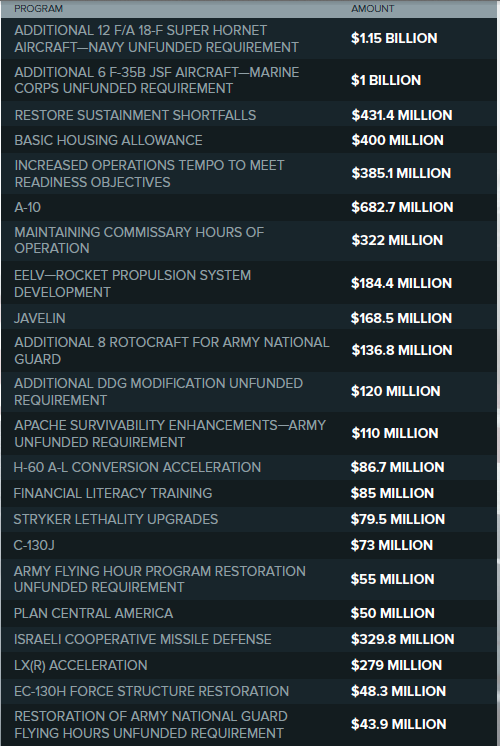HASC NDAA Mark Challenges White House From A-10 To Iraq To Space
Posted on
WASHINGTON: If anyone at the White House had hoped the new chairman of the House Armed Services Committee would be more compliant than his predecessor, the defense bill out today should end their illusions. Sure, Rep. Mac Thornberry has consulted closely with the Pentagon and his ranking member on issues like acquisition reform.
But Thornberry’s draft of the National Defense Authorization Act for 2016 would seem in many ways a repeat of last year’s discussion between the Obama administration and the Hill. The administration wanted authority to close bases, retire the A-10 fleet, and to rejigger military pay and benefits last year, among other things. Here’s what the 2016 NDAA draft from the HASC would do:
- It authorizes $682.7 million to save the A-10 “Warthog” ground attack plane, the Army’s favorite Air Force program. Reallocating specific funds to the A-10, at the expense of other programs, is a more concrete measure than past congressional declarations that the aircraft simply mustn’t retire. It also halves the number of A-10s the Air Force is allowed to mothball in ’16, from 36 to 18. The bill doesn’t forbid A-10 retirement outright, but expect an amendment at Wednesday’s marathon mark-up session: “With funding secured, the Chairman would welcome efforts at markup to prohibit the retirement of the A-10 fleet,” the official summary says.
- The bill would also block the Air Force plan to retire half its fleet of EC-130H Compass Call aircraft, adding $48 million to keep the unique electronic warfare planes. Meanwhile the Navy gets an extra $1.2 billion for a dozen new F/A-18E/F Super Hornets and the Marines get $1 billion for six additional F-35B Joint Strike Fighters.
- The National Guard gets $139 million for eight new UH-60M Black Hawk helicopters and $87 million for upgrades to old UH-60As, while the regular Army gets $110 million to upgrade its AH-64 Apache gunships and $80 million for Stryker vehicle upgrades.
- It funds the requested $715 million for aid to Iraq, but with caveats that will frustrate the White House and outrage Baghdad. First, the bill earmarks 25 percent of the money ($179 million) for forces not truly subject to the Shiite-dominated central government: Kurdish Pershmerga, Sunni tribes, and the nascent Iraqi National Guard, a collection of Sunni militias — all of which would be officially deemed “countries” to allow them to receive US aid directly, bypassing Baghdad.
What’s more, the bill would withhold the remaining 75 percent until the Secretaries of Defense and State formally tell Congress that “Government of Iraq is meeting certain conditions relating to political inclusion of ethnic and sectarian minorities within the security forces of Iraq.” If the administration finds Baghdad isn’t meeting the standard — and there’s no waiver provision allowing them to say “yes, but” — no money would go to the central government, and 60 percent would go to the Kurds and Sunnis.
The bill “rescinds the President’s authority to unilaterally transfer detainees” from the prison at Guantanamo Bay, reinstating stricter congressional controls from the 2013 NDAA. This move is part of the backlash against Obama’s release of five prisoners in exchange for captured Army soldier Robert Berghdal. In a statement generally praising Thornberry’s bill, HASC’s top Democrat, Adam Smith, singled out the Guantanamo provision as “perilous policy” and “a political position driving bad policy.”
The mark pushes the Air Force to retire Russian-made RD-180 engines and replace them with US-made rocket boosters. Specifically, the bill provides $187 million more to develop the new engine, but no more time, keeping to a strict 2019 deadline. Air Force Secretary Deborah Lee James, industry leaders, and others have said this is the kind of tough technical problem that can’t be rushed: Throwing more money at it and expecting invention on deadline may just end in rush to failure, they argue.
The bill lauds the Defense Department’s downsizing efforts and offers it new flexibility in managing its workforce — but only if it meets a multitude of preconditions. The budget, military manpower, and contractor workforce must all be downsized as well as the civil service; attrition and voluntary incentives must be the first resort before involuntarily getting rid of civilians; and no job vacated by a civilian federal worker may be filled by a contractor “for six years” (boldface in the original). The president of the Professional Services Council, which advocates for more flexible workforce management (and more use of contractors) said the NDAA provision “strikes me as half a loaf.”
“Those kind of restrictions tend to really limit your ability to do smart human capital planning and strategy,” PSC president Stan Soloway told me.
At the same time, the bill eases the restrictions on multi-year procurement contracts, a cost-saving measure favored by industry but which Congress has historically restricted in favor of buying things year-by-year. Under current law, agencies “must determine that substantial savings would be achieved before entering into a multiyear contract.” The HASC NDAA would lower that threshold to “a reasonable expectation that the use of a multiyear contract would result in lower total anticipated costs.” That could give much more freedom to Pentagon acquisition officials. But Frank Kendall, the head of Pentagon acquisition, has signaled he isn’t comfortable with this approach: He likes having the “substantial savings” requirement in law as a tool to extract pricing concessions from contractors.
Another measure that might do more to endear Thornberry to Pentagon officials: The bill would, “over the next six years, eliminate over 460 congressionally-mandated reports.”
Thornberry’s purge of obsolete annual reports doesn’t mean he swears off the use of reporting requirement as a policy tool. To the contrary, the bill includes some extremely interesting report requirements that could help shape the future of the force:
It asks the Defense Department to submit a general strategy to counter “unconventional threats [from both] state and non-state actors,” plus a specific study on the Russian threat. The danger is not just conventional forces, the bill emphasizes, but the combination of those forces with “propaganda in media, economic warfare, cyber warfare, criminal acts, and intelligence operations.
It asks the Defense Department to study “the feasibility, utility, and options for mobile, land-based systems to provide anti-ship fires.” Former Defense Secretary Chuck Hagel, Seapower subcommittee chairman Randy Forbes, the thinktank CSBA, and (elliptically) the new Army Operating Concept have all touted land-based ship-killer missiles as a way to level the balance of power in the Western Pacific against China’s 2nd Artillery Force. It could also be a major new mission for the Army.
Updated 6:20 pm with Stan Soloway comment

Selected plus-ups in the HASC draft of the National Defense Authorization Act
Subscribe to our newsletter
Promotions, new products and sales. Directly to your inbox.

